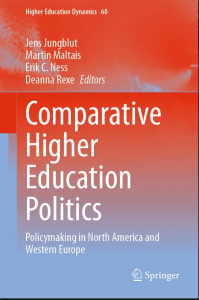Comparative Higher Education Politics. Policymaking in North America and Western Europe
Jens Jungblut
 Several people have argued in recent years that higher education has become a more important policy sector in most if not all countries around the world (see e.g. Busemeyer, Garritzmann, & Neimanns, 2020; Garritzmann, 2016; Gornitzka & Maassen, 2014). An increasing percentage of the global population pursues or attains a tertiary education degree, both private and public spending for higher education is growing, and the relevance of well-trained graduates but also research and innovation for national economic development or the solution of global policy problems such as climate change is steadily increasing.
Several people have argued in recent years that higher education has become a more important policy sector in most if not all countries around the world (see e.g. Busemeyer, Garritzmann, & Neimanns, 2020; Garritzmann, 2016; Gornitzka & Maassen, 2014). An increasing percentage of the global population pursues or attains a tertiary education degree, both private and public spending for higher education is growing, and the relevance of well-trained graduates but also research and innovation for national economic development or the solution of global policy problems such as climate change is steadily increasing.
All these aspects make higher education more politically relevant, and some argue that this increased relevance also goes hand in hand with a greater political focus on what happens in higher education and how it is regulated. To use terminology developed by Busemeyer, Garritzmann and Neimanns in their 2020 book “A loud but noisy signal? Public opinion and education reform in Western Europe”, higher education policy seems to have moved from quiet politics to loud politics. This means that issues related to higher education policy receive more salience in public and political debate and policymaking is less characterised by sector-specific approaches, e.g. a collaboration between a ministerial bureaucracy and the higher education sector. All this goes to say that one can expect that the way higher education policy is made has changed.
This is the backdrop for our edited volume “Comparative Higher Education Politics. Policymaking in North America and Western Europe”. Another realisation that motivated the volume is that there is only very limited comparative scholarship that engages with higher education policy research on both sides of the Atlantic (Cantwell et al. (2018) is one of the few exceptions). Both observations motivated us to engage in a structured comparison of key aspects of higher education policymaking in Western Europe, Canada, and the US. In doing so, we want the volume to fulfil three functions: 1) provide an overview of the relevant literature, 2) present new empirical research, and 3) allow for structured comparison of the three regional contexts.
Conceptual foundation & structure
To ensure linkages between the chapters, we based the volume on a clear conceptual framework. In this, we use two strands of institutional theory, the global rationalization argument from sociological institutionalism as well as arguments of path-dependence from historical institutionalism, to create a common frame of reference. While sociological institutionalism highlights the global spread of scripts, ideas, organizational models, or structures resulting in global convergence, historical institutionalism focuses rather on path dependence of earlier decision that maintain national divergence. We use these two opposing sets of expectations as the foundation for our comparison between Western Europe, Canada, and the US as we try to elucidate whether higher education policymaking in the three regions has converged or whether we continue to see lasting differences.
To provide a clear structure, we organize the volume along five key aspects of policymaking, each representing not only specific policymaking dynamics but also a separate strand of research literature. The five key aspects are: the politics of higher education governance reforms, the politics of higher education finance, framing of higher education policy, intermediary organizations and interest groups in higher education policy, and policy transfer and diffusion. The volume has one section for each of the aspects. Each section includes one chapter for each of the three regions as well as a shorter comparative chapter that summarizes findings. As the volume has a clear comparative orientation, comparisons between entities are made in each chapter, in the five sections as well as across the sections.
Main results
Looking at all the results from the book, the concluding chapter provides an overview of the state of the art of higher education policymaking in Western Europe, Canada, and the US. The overall picture that emerges is one of continued divergence and the importance of national path dependence. However, there are several aspects where one can observe converging dynamics, and these are therefore especially interesting. While the federal or European level only have very limited competences in higher education policy in all three regions, they are getting more involved in recent years mainly through the provision of funds with the aim to steer (parts of) higher education towards policy goals that are relevant for them.
Another converging aspect that can be observed across all contexts is that the set of actors involved in higher education policymaking is becoming more diverse. As higher education policy becomes more politically salient and its outputs become increasingly relevant for addressing problems in other policy areas (e.g. climate change), a greater number of policy actors with diverse characteristics and preferences gets involved in policy processes related to higher education.
Another common trend is that most higher education systems move towards more university autonomy in their governance arrangements, prioritizing steering at a distant over more direct political control. However, in all contexts one can observe policy issues for which institutional autonomy is being limited by political actors in recent years. These shifts are linked to processes in which higher education policy get increasingly politicized as the sector is linked to more general political debates. Examples here include questions about the role of gender- or race-related issues on university curricula or discussions regarding limitations on international research collaborations in the context of competing national interests.
Implications for higher education policy research
Overall, the findings from the volume highlight the persistence of divergence in higher education policy on both sides of the Atlantic as policymaking dynamics are driven by national politico-administrative context and local policy agendas.One could say that Western Europe and the U.S. mark the ends of a continuum in policymaking with Canada combining aspects from both areas. However, we also see convergence of dynamics across all three contexts such as the greater number and more diverse set of actors involved in policymaking. This reiterates earlier arguments that portrayed modern higher education policy as a multi-issue, multi-level, and multi-actor policy field (see: Chou, Jungblut, Ravinet, & Vukasovic, 2017).
Also, higher education policy is becoming more politicized in all three contexts as links to other policy areas and debates grow. In parallel, we can observe a growing demand in all regions that public funding is tied to demonstrating performance and an ongoing balancing act regarding the autonomy of higher education from the state. Conceptually speaking our findings agree with arguments proposed by Christensen et al. (2014), who highlight that while global reform scripts do exist in higher education policy, national filters influence how these scripts are implemented in local contexts. Thus, we can still find national variation in policymaking even if many global reform ideas have been embraced by policymakers around the world.
To sum up our observations, one can state that universities have always responded to social needs and political expectations in their environment. After all, this is how they survived as organizations for such a long time and why they are important institutions for the modern state. However, today’s universities are embedded in a more complex political environment that relies on them to provide solutions to many different policy problems. This makes higher education politically more important, but it also makes governments treat it less special. Using the argument by Busemeyer et al. (2020) mentioned above, one could say that we observe a shift from quiet to loud politics. This opens the questions how universities will react to this new political environment where they are more often in the political focus and whether they will become more political actors in response to an increased politicization. Some results, for example in the chapter about interest groups in the U.S., point in this direction and we believe this can be an important avenue for future research.
Jens Jungblut works as an Associate Professor at the Department of Political Science at the University of Oslo and is one of the Circle U. Academic Chairs on Democracy. Prior to this, he was a postdoctoral research fellow at the Scandinavian Consortium for Organizational Research (SCANCOR) at Stanford University and a postdoctoral researcher at the International Centre for Higher Education Research (INCHER) at the University of Kassel. He received his PhD from the University of Oslo. Jens’ main research interests include party politics, policy-making, and public governance in the knowledge policy domain (higher education & research), organizational change in higher education, agenda-setting research, and the role of (academic) expertise in policy advice.
Literature:
Busemeyer, M. R., Garritzmann, J. L., & Neimanns, E. (2020). A Loud but Noisy Signal? Cambridge: Cambridge University Press.
Cantwell, B., Coates, H., & King, R. (Eds.). (2018). Handbook on the Politics of Higher Education Cheltenham: Edward Elgar.
Chou, M.-H., Jungblut, J., Ravinet, P., & Vukasovic, M. (2017). Higher education governance and policy: an introduction to multi-issue, multi-level and multi-actor dynamics. Policy and Society, 36(1), 1-15. doi:10.1080/14494035.2017.1287999
Christensen, T., Gornitzka, Å., & Maassen, P. (2014). Global Pressures and National Cultures. A Nordic University Template? In P. Mattei (Ed.), University Adaptation in Difficult Economic Times (pp. 30-51). Oxford: Oxford University Press.
Garritzmann, J. L. (2016). The Political Economy of Higher Education Finance: The Politics of Tuition Fees and Subsidies in OECD Countries,1945–2015. Basingstoke: Palgrave Macmillan.
Gornitzka, Å., & Maassen, P. (2014). Dynamics of Convergence and Divergence. Exploring Accounts of Higher Education Policy Change. In P. Mattei (Ed.), University Adaptation in Difficult Economic Times (pp. 13-29). Oxford: Oxford University Press.
This post was initially published on Europe of Knowledge blog.

